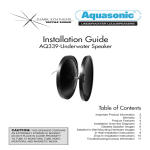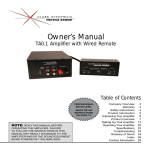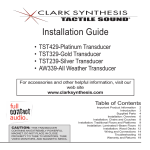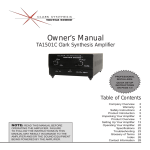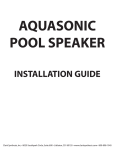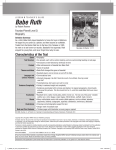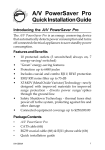Download Clark Synthesis TST239 Installation guide
Transcript
tactile sound transducer Installation Guide TST429-Platinum, TST329-Gold, TST239-Silver, AW339-All Weather 0707 Clark Synthesis Table of Contents ©2007 Clark Synthesis, Inc. • 8020 Southpark Circle, Suite 600, Littleton, Colorado 80120 tel: 303.797.7500 • fax: 303.797.7501 • e-mail: [email protected] • www.clarksynthesis.com CAUTION: THE TACTILE SOUND TRANSDUCER CONTAINS AN EXTREMELY POWERFUL MAGNET. DO NOT PLACE IN CLOSE PROXIMITY TO TV SETS, VIDEO MONITORS, AND MAGNETIC MEDIA (TAPES). Introduction Related Products Supplied/Required/Optional Items General Installation Tips 1 2 3 4 Installation… Overview Chairs & Couches Traditional Floors & Platforms Laminated I-Beam Floors Wood Decks Wiring & Connections Troubleshooting Warranty 5 7 8 9 10 11 13 14 Introduction Warranty United States Warranty and Return Policy Before you drill holes and run wires, take a few moments to review this Installation Guide. Then plan out the steps you’ll need to take for your particular application. This will save you time in the end and reduce the possibility of errors and/or damage to the transducer. TACTILE SOUND TRANSDUCER WARRANTY Clark Synthesis, Inc. warranties Transducers TST239, TST329, TST429, and AW339 to be free from defects and workmanship under normal use for a period of two (2) years from date of original purchase. For industrial or commercial use, the warranty period is six (6) months. Should warranty service be necessary, Clark Synthesis, Inc. will (at its discretion) repair or replace the defective merchandise with equivalent merchandise at no charge. Thank you for purchasing a Clark Synthesis™ Tactile Sound™ Transducer, and welcome to the amazing world of Tactile Sound! For many years, Clark Synthesis has been giving its customers the ability to experience sound in a completely different way. As you know, most of the sound we hear reaches our ears via airborne vibrations, like those produced by loudspeakers. However, there are four additional pathways through which we perceive acoustic energy, all of which fall into the category of tactile sound. These additional pathways include: • Deep tissue and muscle mass (“Kinesthetic”) • Skeletal joints (“Haptic”) • Skin sensation (sense of touch) • Bone conduction (skull-to-cochlea transmission) To capitalize on these additional means by which we perceive acoustic energy, Tactile Sound Transducers have been designed to send high-quality audio to the listener by producing vibrations over a full range of tactile and audible frequencies. When attached to a resonant surface, the Transducers supplement ordinary speakers and subwoofers, effectively increasing the proportion of tactile sound. Consequently, you feel the natural percussive impact of sounds, bringing life to sound effects like hard footsteps, door slams, plucked strings, drum beats, and explosive movie effects, all while enjoying greater clarity, depth, and realism. Some of the most common applications for Tactile Sound Transducers include home theaters, listening rooms, outdoor decks, military simulators, theme park attractions, game chairs, professional music, and swimming pools. This warranty is valid for the original purchaser and is not extended to subsequent owners. Any applicable implied warranties are limited in duration to a period of the express warranty as provided herein beginning with the date of the original purchase at retail, and no warranties, whether expressed or implied, shall apply to this product thereafter. Some states do not allow limitations on implied warranties; therefore these exclusions may not apply to you. This warranty gives you specific legal rights; however, you may have other rights that vary state to state. In home theaters and listening rooms, our Transducers provide the user with a greater depth of experience when watching movies, listening to music, and playing video games. WHAT IS NOT COVERED This warranty is valid only if the product is used for the purpose for which it was designed. It does not cover the following: • Damage caused by water or excessive heat • Damage through negligence, misuse, accident, or abuse • Damage caused by incorrectly mounting the transducer • Damage due to not using an appropriate amplifier • Freight damage • Items previously repaired by unauthorized repair facility • Items damaged due to amplifier clipping and/or distortion • Items returned from unauthorized individuals or dealers • Cost of shipping product to Clark Synthesis, Inc. • Return shipping on non-defective items For outdoor applications, our AW339-All Weather Transducers mount underneath decks, keeping the audio equipment out-ofsight while transferring audio to the surface of the deck. Many military and flight simulator companies use our TST329Gold Transducers to bring a greater sense of realism to training exercises. Pool enthusiasts use our AC339-Aquasonic™ underwater pool speakers to send full-range audio into the water, providing high-quality underwater music. As you can see, the uses for our Transducers are many and the experience is amazing! We are glad you chose Clark Synthesis Transducers and we hope your listening experience using our products takes you to new levels of acoustical enjoyment! Additionally, because Transducers increase the perceived “loudness” of the sound you are hearing, you are able to lower the volume on your system to a level that is both safer for your ears and less bothersome to neighbors. RETURN POLICY New, unused items purchased from us may be returned within 7 days of the purchase date. Please note: Clark Synthesis will only accept returns for items that are received in their original packaging, in undamaged and re-sellable (new) condition. Manuals, accessories, warranty cards, and everything else that came with the unit must be included as well. If your return does not meet these conditions, you will be charged a 15% restocking fee or have the merchandise returned to you at your expense. Non-defective merchandise can also be returned for a 15% restocking fee. Shipping charges for all non-defective returns or exchanges are not refundable. WHAT TO DO IF YOU NEED WARRANTY OR SERVICE If it becomes necessary for you to return defective merchandise, call Clark Synthesis Customer Service at 303. 797.7500 and you will be given a Return Authorization Number. Follow the instructions provided by our customer service staff, use suitable packing materials (preferably the original shipping boxes), and make sure to write your Return Authorization Number on the outside of your box when sending your return to us. Orders that are returned without a Return Authorization Number may be refused by our returns department! Remember to include a dated proof of purchase from an authorized dealer. Freight must be prepaid: items received freight collect will be refused. Make sure the following is included in your package: • Product to be returned (repacked in original shipping containers) • Return Authorization Number printed on the outside of the box • Copy of original invoice with Return Authorization Number printed on it Return to our Service Department: RA#: _______________ Clark Synthesis, Inc. 8020 Southpark Circle, Suite 600 Littleton, Colorado 80120 INTERNATIONAL WARRANTY Contact your International Clark Synthesis dealer or distributor concerning specific procedures for your country's warranty policies. 1 tactile sound transducer www.clarksynthesis.com www.clarksynthesis.com tactile sound transducer 14 Related Products Troubleshooting Clark Synthesis, Inc. wants to help make every installation the best it can be because we are proud of our superior technical support. However, before calling us directly to discuss any technical issues, please consult the following troubleshooting information. Clark Synthesis technical support can be reached by calling 303.797.7500, weekdays from 9am to 5pm, Mountain Standard Time or by emailing us at [email protected]. You can also find additional installation notes at www.clarksynthesis.com. Want more tactile sound in furniture/platform • Add isolation feet to your funiture or riser to keep the tactile feel from transferring into the floor. Not enough volume with multiple Transducers • Make sure the polarity (the + and – speaker leads) is the same on all Transducers. An improperly-wired Transducer will cancel much of the output of a properly-wired Transducer. Isolation Feet: Adding isolation feet to your home theater furniture or platform improves the tactile experience by reducing energy losses into the floor. Clark Synthesis, Inc. carries three different models of isolation feet, each designed to enhance a variety of tactile applications. Amplifiers: Clark Synthesis, Inc. sells amplifiers that work great with Clark Transducers. Some of these amplifiers will drive multiple transducers. Contact Clark Synthesis, Inc. for more information. The Transducer touches the floor under my chair • The body of the Transducer should not be in contact with any object or surface. • Raise the chair’s feet to clear enough space for the Transducer. • Or, if space permits, mount the Transducer fastener side down inside the chair. TI-100 TI-200 TI-300 I hear rattles or buzzes • Make sure the jam nuts and hardware connections are secure and tight. • Make sure the body of the Transducer and its speaker wire are not in contact with any object or surface. • Make sure the Tactile Amplifier is not clipping or distorting. Tactile Ready™ Theater Seats Theater seats bearing the Tactile Ready designation include a convenient mounting point for installing a Clark Synthesis Transducer in an ideal location for transmission of tactile vibrations. Such seats have been tested and certified as Tactile Ready™ by Clark Synthesis, Inc. • If you are using an equalizer, cut the bass frequencies starting with the lowest band. I hear buzzes from my recliner • Try wrapping waxed dental floss (any flavor!) in the scissor hinges of the footrest to dampen the vibrations. • Inspect the recliner for other loose metal parts and tighten. I hear voices coming from my chair! • Make sure the Tactile Amplifier is connected to the LF/RF outputs of your surround-sound component. The Transducer has shut down • The Transducer has an internal early-warning circuit that warns you of too much power or too much distortion. The early warning circuit will automatically reset when the condition has been remedied. • Lower the volume of the Tactile Amplifier. 13 tactile sound transducer www.clarksynthesis.com www.clarksynthesis.com tactile sound transducer 2 Supplied/Required/Optional Items Wiring & Connections 1 REQUIRED TOOLS AND MATERIALS Depending on your application, you will need some or all of these tools and materials for installation: SUPPLIED PARTS (ILLUSTRATED BELOW) A. (1) Tactile Sound Transducer B. (1) Unimount Bracket C. (1) 3/8"-16 x 3” Hanger Bolt D. (1) 3/8"-16 x 3” Threaded Stud E. (1) 3/8"-16 x 1.5” Threaded Stud F. (1) 3/8"-16 x 1” Hex Bolt G. (4) #12 x 1" Screw H. (2) 3/8" Nut I. (4) #12 Washer J. (4) #12 Lock Washer K. (1) 3/8” Washer L. (1) 3/8” Lock Washer M. (1) T-Nut • Installation Guide • • • • • • • • #2 Phillips Screwdriver (2) 9/16" Open-Ended Wrenches Drill Saw Wire Stripper Soldering Gun or Wire Nuts Adhesive (construction glue) Hardwood (oak, maple, ash, etc., not pine or softwoods) for creating mounting bridges • Speaker Cable (min. 16 AWG; 12-14 AWG recommended) Connecting to the FRONT Outputs of a surround-sound processor or receiver • An optional equalizer allows you to tailor the frequency response of the Transducer. TACTILE AMPLIFIER SURROUND-SOUND PROCESSOR OR RECEIVER OUTPUTS SPEAKER OUTPUT AUDIO IN FRONT 2 B NOTE: If you are using a surround-sound receiver with built-in amplifiers, you DO NOT need to split the FRONT output as shown in this diagram. INPUT Connecting to the LFE/SUB Output of a surround-sound receiver TACTILE AMPLIFIER Front View SUB/LFE EQUALIZER (RECOMMENDED OPTION) Side View A SURROUND SPLIT TO EXTERNAL AMPLIFIER IF APPLICABLE OUTPUT 3-D View CENTER SPEAKER OUTPUT SURROUND-SOUND RECEIVER SUB/LFE AUDIO IN SPLITTER 1 C D E F G H I J K L SPLITTER 2 M TO INPUT OF POWERED SUBWOOFER REQUIRED AUDIO COMPONENTS • Power amplifier: ...for the TST239, rated between 75 and 125 watts @ 4 ohms. ...for the TST329, TST429, and AW339, rated between 125 and 150 watts @ 4 ohms. OPTIONAL AUDIO COMPONENTS • Equalizer to tailor the frequency response of the Transducer(s) . 3 tactile sound transducer www.clarksynthesis.com www.clarksynthesis.com tactile sound transducer 12 Wiring & Connections General Installation Tips Wiring the Transducer is essentially the same as wiring speakers: • Use 16AWG or heavier speaker wire. • Make sure all audio components are OFF before connecting the Transducer. One of the best materials for carrying tactile sound is wood. In most applications, the Transducer should be centrally located on the structure (chair, floor, riser, deck, etc.) in order to evenly distribute the tactile effect. When two or more Transducers are used on one structure, they should be spaced equidistant from each other and the edges/boundaries of the structure. Mounting to a bridge, joist, or frame member is preferred. The diagrams on the following pages show a stereo amplifier powering two Transducers. If only one Transducer is being used – such as in an individual theater seat – you may use an amplifier that can be bridged to mono. Typical mono and stereo connections are illustrated below. (Refer to your amplifier’s instructions for bridging.) Be careful not to overpower the Transducer (see power ratings on Page 3). Powering 1 Transducer with a Bridged Mono Amp BRIDGED MONO TACTILE AMPLIFIER SPEAKER OUTPUT LEFT RIGHT – + – + AUDIO IN L R FROM AUDIO SOURCE NOTE: Multiple Transducers are NOT required for typical seating installations. Powering 2 Transducers with a Stereo Amp STEREO TACTILE AMPLIFIER SPEAKER OUTPUT LEFT RIGHT – + – + AUDIO IN L R GENERAL LOCATION DIAGRAM FROM AUDIO SOURCE Transducer mounted to chair frame Transducer mounted inside riser Transducer mounted beneath floor Speaker Cable Considerations The Transducer includes a permanently attached 3-foot speaker wire. The positive (+) lead is the red wire. Observe this polarity when conecting your amplifier. You may need to use solder or wire nuts to attach a length of speaker cable to reach the amplifier in your audio system. In any permanent installation, a soldered connection is preferred because wire nuts may vibrate loose. NOTE: Transducers are designed to be mounted in a horizontal orientation. Mounting the Transducer vertically may shorten the Transducer’s life. Speaker cable size (gauge) should be calculated for run length; the longer the run, the larger the cable (the lower the gauge). 12 - 14 AWG is recommended; 16 AWG is minimum. CORRECT 11 tactile sound transducer www.clarksynthesis.com www.clarksynthesis.com CORRECT INCORRECT tactile sound transducer 4 Installation: Overview Installation Type: Hanger Bolt Installation Type: Unimount Bracket Installation Type: Hanger Bolt Screws into the bottom of the mounting surface. Requires access only to the bottom of the mounting surface. Requires a flat or nearly flat mounting surface. The AW339-All Weather Transducers are recommended for use on outdoor installations, including decks, boat docks, etc. Screws into the bottom of the mounting surface (into a 5/16" drilled hole). Requires access only to the bottom of the mounting surface. Min. 4-1/2" vertical space required, including 1/2" clearance between the Transducer and floor. Min. 3-1/4" vertical space required, including 1/2" clearance between the Transducer and floor. Minimum 3/4"-thick 3/4"-thick mounting surface Joist (edge view) Drill 5/16" hole Tip: Tighten two Jam Nuts against each other to screw in Hanger Bolt using wrench. Unimount Bracket Flat Washer Installation: Wood Decks 3/8"-16 Hanger Bolt For decks, we recommend using one (1) All Weather Transducer for every 10 ft. by 10 ft. section of deck. For example, if you have a deck that measres 10 ft. by 30 ft., we would suggest you install three (3) Transducers. Deck joists 16" - 24" on center For all installations, regardless of the number of Transducers, we recommend locating the Transducers equidistant from the edges of the deck and/or from each other. This helps create a more uniform distribution of the tactile effect. The easiest installation method is to use the Hanger Bolt to mount the Transducer(s) to the bottom of the joist(s). Steps for this installation method can be found on Page 8. TST mounts directly to bottom of joist using Hanger Bolt Note: If for some reason it is not possible to mount to the joists, use a bridge between joists as you would in a floor installation (see Page 8 for instructions and images for building a bridge). MOUNTING DETAIL joist (edge view) It is important to make Transducer wire connections as watertight as possible by using electrical tape and molded plastic connectors. Hanger Bolt Tip: Tighten two Jam Nuts against each other to screw in Hanger Bolt using wrench. Jam Nut (down) Lock Washer Jam Nut Screw Jam Nut (up) 3/8"-16 Threaded Stud Jam Nut (down) NEVER TIGHTEN BY TURNING THE TRANSDUCER. MAKE SURE TO TIGHTEN THE JAM NUT NUT AGAINST THE TRANSDUCER’S BRASS NUT. Transducer Wire Lead Jam Nut Transducer Wire Lead Washers Machine Screw Jam Nuts 5 tactile sound transducer www.clarksynthesis.com www.clarksynthesis.com tactile sound transducer 10 Installation: Laminated I-Beam Floors Installation: Overview Installation Type: Unimount Bracket or T-Nut Installation Type: T-Nut The Transducer will be mounted to a bridge that spans adjacent floor joists and is parallel to the floor. Transducer mounts on 1"x 6" hardwood bridge spanning two joists, using the Unimount Bracket (shown) or the Threaded Stud with T-Nut. Attach the bridge to the bottom face of the joists using adhesive and screws. MOUNTING DETAIL MOUNTING DETAIL T-Nut Washers Jam Nuts Screws Using Unimount Bracket Requires initial access to the top of the material to insert the T-Nut, which installs near flush to the surface. (Drill a 7/16" hole for the T-Nut.) LAMINATED I-BEAM FLOORS Laminated I-Beam Joists Jam Nuts Washers Using T-Nut Steps for installation using the Unimount Bracket 1. Attach the Unimount Bracket to the mounting surface using machine screws with flat washers and lock washers. 2. Screw the a Threaded Stud into the threaded insert on the Unimount Bracket. 3. Spin the two Jam Nuts onto the stud. You will tighten them later. 4. Screw the Transducer onto the Stud until a slight resistance is felt (approx. 5 or 6 turns). When resistance is felt, stop turning. • DO NOT OVERTIGHTEN THE TRANSDUCER! 5. Tighten one Jam Nut against the Unimount Bracket. 6. Tighten the other Jam Nut against the Transducer’s brass nut using two 9/16” wrenches as follows: One wrench firmly grasping the Transducer’s brass nut while the second tightens the Jam Nut against it. • NEVER TIGHTEN BY TURNING THE TRANSDUCER – MAKE SURE TO TIGHTEN THE JAM NUT AGAINST THE TRANSDUCER’S BRASS NUT. 7. Use solder or wire nuts to connect speaker wire to the Transducer’s wire leads. 8. Run the speaker wire to your audio system. 9. Connect the Transducer to your audio system (see “Wiring and Connections” later in this guide). Steps for installation using the T-Nut Method (See diagram in “Installation: Chairs and Couches”). For use with metal or some other high-tensile mounting surfaces no thicker than 1/4". Requires access to the top of the mounting surface both to install the bolt and to tighten it. Min. 3-1/2" vertical space required, including 1/2” clearance between the Transducer and floor. Min. 3-1/4" vertical space required, including 1/2" clearance between the Transducer and floor. Drill 7/16" hole 3/4"-thick mounting surface Drill 7/16" hole T-Nut 3/8"-16 Hex Bolt Flat Washer max. 1/4"-thick mounting surface Lock Washer Jam Nut (up) Flat Washer Lock Washer 3/8"-16 Threaded Stud Jam Nut (up) Jam Nut (down) Transducer Wire Lead 1. Drill a 7/16” hole in the mounting surface, being careful not to drill through existing materials behind your mounting surface. Press the T-nut into the hole on the side of the mounting surface opposite the Transducer (see diagram). 2. Screw a Threaded Stud completely into the T-Nut. 3. Place the 3/8” flat washer and 3/8” lock washer on the Threaded Stud, then spin the two Jam Nuts onto the stud (flat washer against the mounting surface, lock washer between flat washer and jam nut). You will tighten the jam nuts later. 4. Screw the Transducer onto the Stud until slight resistance is felt (approx. 5 or 6 turns). When resistance is felt, stop turning. • DO NOT OVERTIGHTEN THE TRANSDUCER! 5. Tighten one Jam Nut against the lock washer, flat washer, and mounting surface. 6. Follow steps 6 through 9 under “Steps for installation using the Unimount Bracket” (as shown above). 9 tactile sound transducer Installation Type: Hex Bolt NEVER TIGHTEN BY TURNING THE TRANSDUCER. MAKE SURE TO TIGHTEN THE JAM NUT AGAINST THE TRANSDUCER’S BRASS NUT. Jam Nut (down) Transducer Wire Lead Flat Washer www.clarksynthesis.com www.clarksynthesis.com Washers Lock Washer Jam Nuts Jam Nuts tactile sound transducer 6 Installation: Chairs & Couches Installation Type: Unimount Bracket or T-Nut Floor joists 16" on center If you want to use Transducers under the floor to supplement a music system, then you should seek an evenly distributed effect. Transducers may be mounted under a floor by attaching a bridge connected between adjacent floor joists. As a general rule, most chairs and couches have an underlying wooden frame. The Transducer can be mounted directly to a frame member or to a hard wood bridge (see diagram) that is rigidly secured to the chair’s/couch’s base. The bridge should be at least 3/4" thick and cut to span two frame members or connect two sides of a box frame. The more centrally located the frame member or bridge is on the overall structure, the better the distribution of tactile sound. If your goal is to activate the area of the floor directly beneath a chair, then attach the Transducer to the closest joist underneath the chair. Tip: Tighten two Jam Nuts against each other to screw in Hanger Bolt using wrench. Note: Carpeting and padding may reduce the tactile effect. CAUTION: When used in recliners, make sure that the Transducer and its wire do not interfere with the recliner’s mechanical elements. Also, a minimum clearance from floor to mounting surface for these types of installs is 4-1/2 inches for the Unimount Bracket and 3-1/2 inches for the T-Nut. PLATFORMS Recommendation: Clark Synthesis recommends using only TST429-Platinum Transducers for platforms. Use of (1) TST429-Platinum for every 4 ft. by 8 ft. section of platform is suggested. Steps for installation using the Unimount Bracket Hardwood Bridge (min. 3/4" thick) Transducer mounts on hardwood bridge attached to chair frame, or to a centrally-located frame member, if present. Bridge should be min. 3/4" thick and 6" – 8" wide. 1. Drill a 7/16” hole in the mounting surface, being careful not to drill through existing springs, padding, strapping, etc. Press the T-nut into the hole on the side of the mounting surface opposite the Transducer (see diagram). 2. Screw a Threaded Stud completely into the T-Nut. 3. Place the 3/8” flat washer and 3/8” lock washer on the Threaded Stud, then spin the two Jam Nuts onto the stud (flat washer against the mounting surface, lock washer between flat washer and jam nut). You will tighten the jam nuts later. 4. Screw the Transducer onto the Stud until slight resistance is felt (approx. 5 or 6 turns). When resistance is felt, stop turning. • DO NOT OVERTIGHTEN THE TRANSDUCER! 5. Tighten one Jam Nut against the lock washer, flat washer, and mounting surface. 6. Follow steps 6 through 9 under “Steps for installation using the Unimount Bracket” (as shown above). Platforms are a great alternative to mounting a Transducer directly to a chair. This method is especially practical in home theaters with multiple rows of seating where back rows are elevated on a riser. An activated platform will deliver tactile sensations to your feet as well as the rest of your body via the chair. Whether constructing a new platform or fitting Transducers onto an existing platform, it is best to space the Transducers equidistant from each other and the edges of the platform. If using only one Transducer, locate it in the center of the platform. To minimize energy loss into the floor, use Isolation Feet between the platform and the floor (see Page 2). MOUNTING DETAIL NOTE: Clark Synthesis does not recommend using MDF (medium-density fiberboard) in a platform. Transducer mounts using Hanger Bolt on 2"x 6" hardwood bridge between joists. If vertical space is limited, cut a curved or rectangular niche in the bridge for the Transducer (see mounting detail). Attach the bridge to the floor (adhesive) and to the joists (adhesive and screws). CAUTION: Do not cut curves in existing joists. MOUNTING DETAIL 2"x 6" bridge with curved niche Jam Nut Glue and screw plywood floor surface to all frame members including the bridge Transducer mounts in niche on 2"x 6" bridge using Hanger Bolt Glue & screw all joints Washers Screws Jam Nuts Steps for installation using the T-Nut Method Using Unimount Bracket MOUNTING DETAIL T-Nut Jam Nuts Washers Using T-Nut 7 tactile sound transducer Installation: Traditional Floors & Platforms TRADITIONAL FLOORS NOTE: If your chair or couch cannot accommodate a Transducer, consider purchasing or constructing a platform (see “Platforms” on Page 8). 1. Attach the Unimount Bracket to the mounting surface using machine screws with flat washers and lock washers. 2. Screw a Threaded Stud into the threaded insert on the Unimount Bracket. 3. Spin the two Jam Nuts onto the stud. You will tighten them later. 4. Screw the Transducer onto the Stud until slight resistance is felt (approx. 5 or 6 turns). When resistance is felt, stop turning. • DO NOT OVERTIGHTEN THE TRANSDUCER! 5. Tighten one Jam Nut against the threaded insert of the Unimount Bracket. 6. Tighten the other Jam Nut against the Transducer’s brass nut using two 9/16" wrenches as follows: One wrench firmly grasping the Transducer’s brass nut while the second tightens the Jam Nut against it. • NEVER TIGHTEN BY TURNING THE TRANSDUCER – MAKE SURE TO TIGHTEN THE JAM NUT AGAINST THE TRANSDUCER’S BRASS NUT. 7. Use solder or wire nuts to connect the necessary length of speaker wire to the Transducer’s wire leads. 8. Run the speaker wire to your audio system. 9. Connect the Transducer to your audio system (see “Wiring and Connections” later in this guide). Installation Type: Hanger Bolt www.clarksynthesis.com Steps for installation using the Hanger Bolt 1. Drill a 5/16" hole in the wood mounting surface and screw in the pointed end of the Hanger Bolt until it is secure. 2. Spin one Jam Nut onto the Hanger Bolt approximately 1”. 3. Screw the Transducer onto the Hanger Bolt until slight resistance is felt (approx. 5 or 6 turns). When slight resistance is felt, stop turning. • DO NOT OVERTIGHTEN THE TRANSDUCER! 4. Tighten the Jam Nut against the Transducer’s brass nut using two 9/16" wrenches as follows: One wrench firmly grasping the Transducer’s brass fastener while the second tightens the Jam Nut against it. • NEVER TIGHTEN BY TURNING THE TRANSDUCER – MAKE SURE TO TIGHTEN THE JAM NUT AGAINST THE TRANSDUCER’S BRASS NUT. 5. Use solder or wire nuts to connect speaker wire to the Transducer’s wire leads. 6. Run the speaker wire to your audio system. 7. Connect the Transducer to your audio system (see “Wiring and Connections” later in this guide). www.clarksynthesis.com 2"x 6" inner joists 16" on center 2"x 8" outer joist Constructing a platform for optimum Transducer Performance Use 2” x 8” outside joists and 2” x 6” inside joists. The 2” difference in joist height suspends the center of that platform above the actual floor, improving distribution of the tactile vibrations. Use interior-grade plywood for the platform surface. We highly recommend using adhesive and screws instead of nails. Loose fitting joints can cause unwanted vibrations or buzzing noises, particularly between the joists and the platform surface. Shown is a 4'x4' platform, but you can make any size as long as the joists are spaced 24" or 16" on center to provide sufficient rigidity for tactile wave transmission. tactile sound transducer 8








